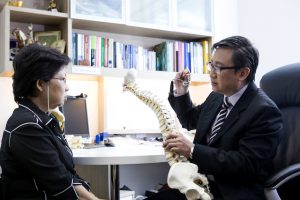Chronic body pain
This can be fibromyalgia, an often-misunderstood condition by both medical and non-medical practitioners and with treatment, patients can be pain-free.
BY: Dr Bernard Lee

Fibromyalgia is a chronic pain syndrome characterised by tight, tender muscles, usually sore points in the neck, shoulders, chest, back, knees and hips.
Sixty-five-year-old Mrs Lee had been suffering from chronic back, buttock and neck pain for more than five years and thought it could be when she had her hysterectomy for fibroids in her womb. She had been trying to bear with it using various conventional methods such as spa massage, acupuncture and TCM, however, they helped only for a short time and the pain would return.
The pain in her back and shoulders would disrupt her sleep at night making it hard for her to have shut-eye. And, when she could sleep, she would feel tired and fatigue the next day. She would complain of back pain when she was stationary in one place such as cooking or sitting down to read the newspaper. She had difficulty getting up from chair. She heard that exercise could help, but when she tried it, she would further aggravate her existing pain.
Besides having chronic back pain, she also had migraine headaches and giddiness. Her headache would flare when her shoulder pain acted up, causing her neck and head to become painful. The giddiness made her unable to focus, feel lassitude and generally unwell.
She had an X-ray of her spine and MRI lumbar spine that showed mild degenerative changes of the spine. However, her doctors were unable to explain the pain from neck down to her back and buttocks. There were no mechanical obstruction or impingement on the nerves.
Mrs Lee felt her back pain stretching from her neck in between the shoulder blades, down to both sides of lower back and bilateral buttocks got worse from any movement, even stretching. She also complained of constantly feeling that her back and shoulder muscles were stiff and tight, and couldn’t be loosen. When morning came, she shared she also had stiffness in her wrist and fingers, which would go away after some time.
The pain left her frustrated and mildly depressed. She was unable do her usual activities. Frequently, the pain would shift from one location to another such as her knees, calves and elbows.
Finding the answer
Generalised pain covering the back, neck and shoulder like what Mrs Lee suffered from are more likely to be due to fibromyalgia syndrome, which is a chronic pain syndrome. In fibromyalgia, it is a “hypersensitivity” of the central nervous system, which causes muscles and soft tissues to go into spasm (hence the tightness and stiffness of muscles and joints).
Fibromyalgia is a generalised syndrome characterised by tight, tender muscles, usually sore points in the neck, shoulders, chest, back, knees and hips and those painful areas may not necessarily mean that the tissue or joint is injured. Disturbed sleep and sometimes depression are associated with this condition. While it is benign and non-progressive, fibromyalgia is chronic. Often it is misunderstood to be degeneration and ageing pain. No specific cause is known; although it sometimes appears following trauma such as a major illness, post surgery, road traffic accident or chronic disease.
This is a misunderstood condition by both medical and non-medical practitioners alike. In fact, many doctors are still ignorant of this condition and have a misconception that this syndrome is a psychiatric condition, or they misunderstand their patients as being difficult or complaining a lot.
Fibromyalgia resembles a number of rheumatic disorders that are known as auto-immune disorders, including rheumatoid arthritis and lupus. Some of these patients may overlap significantly with soft tissue rheumatism and/or chronic fatigue syndrome. Furthermore, it is diagnosed more often in women than in men.
Treatment
After evaluating all of Mrs Lee’s tender points in her body, I treated her in several ways:
- To give quick relief, I desensitised the nerves supplying those tense muscle spasm with nerve block injections. With these specialised injections, I can target those nerves and reduce their sensitivity, and in turn relax the muscles.
- She also needed specialised fibromyalgia treatment with targeted medications to reduce the sensitivity of the nerves and to relax the muscles. Standard painkillers will not be able to stop the pain or relax the muscles. These medicines such Lyrica and Amitriptyline will alter the muscles and stabilise the nerve reactivity.
Within two weeks, her chronic back pain went away. She was able to participate fully in a rehabilitation and exercise programme without any more pain. At her last review, she was happy with the results.
Self-care is very important in the management of fibromyalgia. This includes reducing stress and allowing yourself time to relax, getting enough sleep, exercising regularly (it might increase the pain but doing it gradually and regularly will decrease the symptoms), not overdoing any activity, eating healthily and limiting your caffeine intake.
Dr Bernard Lee is the director and consultant pain specialist of the Singapore Paincare Center.

0 Comments